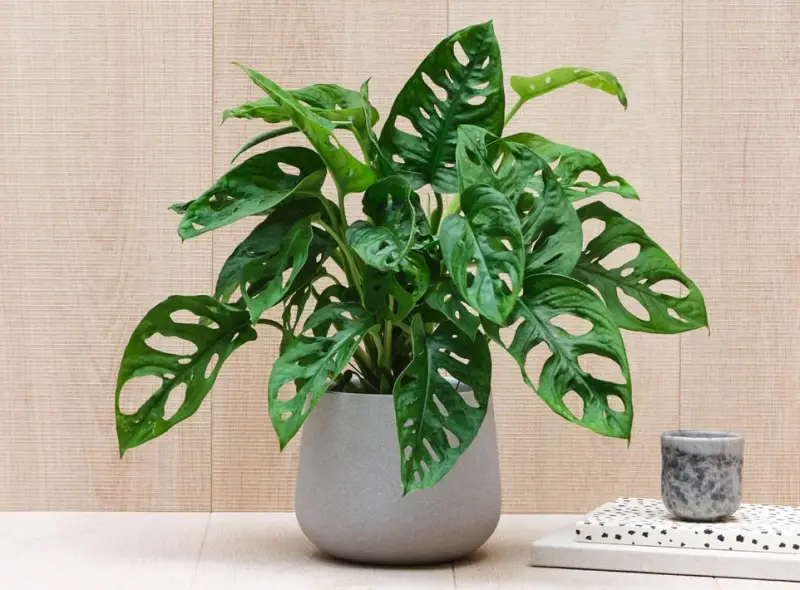The Swiss cheese plant, known scientifically as Monstera adansonii, is a popular houseplant with large, heart-shaped leaves that develop unique holes as they mature, resembling the pattern of Swiss cheese.
This tropical perennial originates from the lush rainforests of Central and South America, making it a favorite among indoor gardeners due to its fast growth, manageable size, and attractive foliage. If you’re looking to grow a thriving Swiss cheese plant, follow this ultimate care and growing guide for optimal results.
What is the Swiss Cheese Plant?

Characteristics and Features
The Monstera adansonii is part of the Araceae family and is closely related to its larger cousin, Monstera deliciosa. While both are commonly called Swiss cheese plants, the Monstera adansonii stands out due to its smaller size and vining growth habit. Indoors, the plant typically reaches between 3 to 8 feet in height, making it more manageable compared to its outdoor counterpart, which can grow up to 13 feet tall.
One key feature of this plant is its unique fenestration—holes in the leaves that grow larger as the plant ages. This adaptation helps the plant withstand heavy rains and wind in its natural habitat. As an indoor plant, Monstera adansonii thrives in indirect light, making it perfect for spaces with filtered sunlight.
Toxicity Warning
It’s essential to note that all parts of the Swiss cheese plant are toxic to pets. Be cautious if you have cats, dogs, or other animals in your household, as ingestion can lead to gastrointestinal issues.
Swiss Cheese Plant Care
Caring for a Swiss cheese plant involves creating the right environment that mimics its natural habitat. Here’s a detailed guide on how to ensure your plant flourishes indoors.
Light Requirements
The Swiss cheese plant (Monstera adansonii) thrives in bright, indirect light, which is essential for its healthy growth. Direct sunlight can scorch its delicate leaves, leading to unsightly burns or yellowing. Ideally, place the plant near a north- or east-facing window, where it can receive ample natural light without being exposed to harsh rays. If direct sunlight is unavoidable, limit exposure to two or three hours of gentle morning sun, as it is less intense and less likely to damage the plant.
In lower light conditions, the Swiss cheese plant may survive, but its growth rate will slow, and its leaves may not develop their characteristic holes. A lack of indirect light can also cause the plant to grow “leggy,” with elongated stems and fewer leaves. If you notice these signs, consider moving the plant to a brighter spot or using a grow light to ensure its well-being.
Ideal Soil Conditions
The Swiss cheese plant thrives in well-draining, peat-based soil, which helps retain moisture without causing the soil to become waterlogged. This type of soil mix is crucial for maintaining a balance between moisture and air circulation around the roots, preventing common issues like root rot.
For optimal growth, the soil pH should be between 5.5 and 7, ensuring a slightly acidic to neutral environment. This range supports healthy nutrient absorption, promoting vigorous growth and lush foliage.
Watering
Water your Swiss cheese plant when the top inch of soil feels dry to the touch. It’s crucial to keep the soil moist but not overly saturated, as overwatering can lead to root rot, a common issue for indoor plants. To prevent this, use a terracotta pot with drainage holes, which helps regulate moisture and allows excess water to escape. After watering, always ensure that any excess water has drained thoroughly from the pot to avoid waterlogging the roots, which can harm the plant’s overall health.
Temperature and Humidity
Swiss cheese plants thrive in warm and humid environments, ideally within a temperature range of 60°F to 85°F. These tropical plants also prefer humidity levels above 50%, which helps maintain their vibrant foliage. If your home is too dry, consider increasing the humidity by using a pebble tray, misting the plant regularly, or placing a humidifier nearby. A bright bathroom or kitchen, where humidity tends to be higher, can serve as an ideal location for your Swiss cheese plant to flourish.
Fertilizing
During the growing season, which typically spans from May to September, it’s essential to feed your Swiss cheese plant with a balanced houseplant fertilizer to support its growth. A fertilizer with an N-P-K ratio of 5-2-3 is particularly effective for this purpose. However, be sure to wait until the plant is well-established after potting, as many potting mixes already contain slow-release nutrients. For optimal results, fertilize your Swiss cheese plant once a month throughout the active growth period, providing it with the necessary nutrients to thrive.
Staking and Support
As a natural climber, the Swiss cheese plant benefits from some form of support, such as a moss pole, stake, or trellis. In its native habitat, this plant utilizes aerial roots to climb trees and other structures, allowing it to reach for sunlight. Providing indoor support encourages the plant to grow upright and prevents it from spreading too far out of its pot. A simple wooden or metal stake placed in the center of the pot can effectively provide the necessary support, helping your Swiss cheese plant maintain its shape and promote healthy growth.
Pruning and Propagation
Pruning Tips
Swiss cheese plants are fast growers and may require regular pruning to keep them manageable indoors. The best time to prune is in spring. Use sterilized pruning shears to trim back overgrown or leggy stems. Always cut just above a leaf node to encourage new growth. Pruning also allows you to remove any damaged or yellowing leaves that detract from the plant’s appearance.
Propagation by Stem Cuttings
One of the easiest ways to propagate a Swiss cheese plant is through stem cuttings. This method is both simple and effective, allowing you to create new plants from pruned sections. Follow these steps to propagate:
- Select a 4- to 6-inch cutting with at least one leaf and one node.
- Remove the leaves from the bottom half of the cutting.
- Apply a rooting hormone to the cut end.
- Plant the cutting in a small container filled with moistened potting mix.
- Place the container in a warm, well-lit area with indirect sunlight.
- Keep the soil slightly moist, and after a few months, roots should develop.
Once the roots are established, transfer the new plant to a larger pot.
Common Pests and Problems
Pests to Watch For
The Swiss cheese plant is relatively resilient, but it can fall prey to a few common houseplant pests, including:
- Mealybugs: These appear as small, white, cotton-like fuzz on the plant.
- Spider mites: Tiny red insects that spin fine webs on the underside of leaves.
- Fungus gnats: Often found in overly moist soil, they lay eggs in the top layer of soil.
To prevent and control these pests, use neem oil or a nontoxic insecticide. Additionally, avoid overwatering to reduce the risk of fungus gnats.
Common Diseases
Root rot is one of the most prevalent issues caused by overwatering. Ensure your plant is never left in standing water. Other possible issues include powdery mildew, rust, and blight. Regular inspection and providing good air circulation can help prevent these problems.
Troubleshooting Common Issues
Yellowing Leaves
Yellow leaves are often a sign of overwatering. Allow the soil to dry out between waterings, and ensure your pot has proper drainage.
Wrinkled or Curling Leaves
Leaves that wrinkle or curl may indicate underwatering. Check the moisture level in the soil, and increase watering as needed. Ensure the plant is receiving sufficient humidity as well.
Black Spots on Leaves
Black spots may be a sign of sunburn from too much direct light. Move your plant to a location with indirect sunlight to prevent further damage.
Drooping Leaves
Drooping can be a sign of inconsistent watering. Ensure that the top inch of soil is dry before watering and provide thorough but not excessive watering each time.
Potting and Repotting Swiss Cheese Plants
Choosing the Right Pot
Select a container with adequate drainage holes to prevent waterlogging. Hanging baskets are a popular option for Swiss cheese plants, allowing their vines to cascade gracefully.
When to Repot
Repot your Swiss cheese plant every two years or when you notice roots poking through the drainage holes. Spring is the best time to repot, as this is when the plant is actively growing.
Conclusion
The Swiss cheese plant (Monstera adansonii) is a rewarding and relatively easy plant to care for indoors. By providing the right environment—ample indirect light, regular watering, and sufficient humidity—you can enjoy its unique foliage year-round. Regular pruning, proper staking, and propagation will keep your plant healthy and looking its best. With this ultimate care guide, you’ll have everything you need to grow a thriving Swiss cheese plant!






